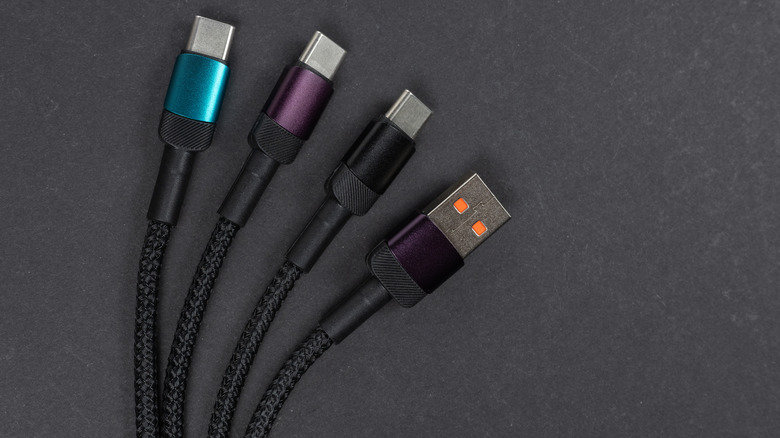What Happens If You Plug A USB 2.0 Cable Into A USB 3.1 Port?
The universal serial bus (USB) was introduced in 1996 and has undergone several upgrades. USB4, the current version, saw a leap in speeds and capabilities much like the versions that came before, including USB 2.0 and USB 3.1. As the term "universal" implies, USB ports are generally compatible with all USB Type-A cables and connectors, which have asymmetrical rectangular ends. The exception is USB Type-C, which uses a different, ovaloid connector. That means a USB 2.0 cable will work if you plug it into a USB 3.1 port. All newer USB ports are backwards compatible, but there is one major drawback: You will be limited by the speeds of the lowest USB version you're using.
If you plug a USB 2.0 cable into a USB 3.1 port, you'll be restricted to the 2.0 speeds — up to 480 megabits per second (Mbps) and a default power output of 2.5 watts. Slower transfer speeds mean files will take longer to move from device to device, like a hard drive to a flash drive, and charging gadgets such as modern smartphones and tablets will take longer. For comparison, USB 3.1 supports transfer speeds up to 10 gigabits per second (Gbps) and a power output of up to 100 watts. You don't really need to know much about tech to understand that bigger numbers allow for faster data transfers and faster electrical charging. So again, if you plug an older USB cable into a newer USB port, it will work fine, but data transfers and power draw will be limited. This is true if you plug a newer USB 3.1 cable into an older USB 2.0 port. The only exception is when the cable or port connectors differ in shape, like USB Type-B or USB Type-C versus USB Type-A.
There's an easy way to tell USB standards
Most of the time (it depends on the computer or device), USB ports have unique colors that denote the standards or speeds in use. Knowing what every USB color means comes in really handy when you're trying to match USB cables and devices. White, for instance, is USB 1.0, or the original standard. Black is USB 2.0, also referred to as high-speed USB, while purple may indicate a proprietary standard from Huawei called SuperCharge, or USB 3.1.
When plugging in USB gadgets, standards can affect devices in different ways. Plugging a power bank into an older USB 2.0 port may limit the charging speeds, especially if the power bank supports faster charging and the Power Delivery (PD) standard. USB Power Delivery was created to achieve a higher-power output, enabling faster charging in devices that use more energy, such as modern smartphones. The older USB 2.0 standard does not support PD.
To sum it all up, so long as the port uses USB Type-A, a cable with a USB Type-A connector will plug in. Devices connected to that cable will work universally, even if it's an older USB standard. You'll just be limited when it comes to file transfer speeds and power delivery by the oldest standard in use. Plug a new smartphone into a USB 2.0 port and you'll see slower speeds and longer charging times.

